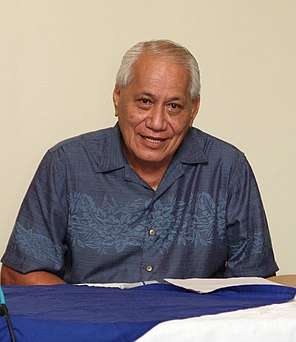Heads of state of Samoa
The O le Ao o le Malo (Samoan: Chieftain of the Government)[lower-alpha 1] is the head of state of Samoa. The position is described in Part III of the 1960 Samoan constitution.[3] At the time the constitution was adopted, it was anticipated that future heads of state would be chosen from among the four Tama a 'Aiga "imperial" paramount chiefs. However, this is not required by the constitution, so, for this reason, Samoa can be considered a republic rather than a constitutional monarchy. The government Press Secretariat describes Head of State as a "ceremonial president". The holder is given the title of Highness, as are the heads of the four paramount chiefly dynasties.
| O le Ao o le Malo of the Independent State of Samoa O le Ao o le Malo o Malo Saʻoloto Tutoʻatasi o Sāmoa | |
|---|---|
 Coat of Arms of the Independent State of Samoa | |
| Style | His Highness |
| Status | Head of State |
| Seat | Apia |
| Appointer | Legislative Assembly of Samoa |
| Term length | Five years, renewable once, consecutively[1] |
| Constituting instrument | Constitution of Samoa |
| Precursor | Monarch of Western Samoa Trust Territory |
| Inaugural holder | Meaʻole and Tanumafili II |
| Formation | 1 January 1962 |
| Salary | 82,000 USD annually[2] |
 |
|---|
| This article is part of a series on the politics and government of Samoa |
| Constitution |
|
Legislative |
|
Judiciary |
|
Administrative divisions |
|
Members of the Council of Deputies act as deputy heads of state, standing in for the Head of State when they are unable to fulfill their duties.
The current Head of State is His Highness Tuimalealiifano Va'aletoa Sualauvi II, who was elected Head of State to a five-year term which started on 21 July 2017.
History of the office
When Samoa became independent on January 1, 1962, two[4] of the four paramount chiefs (Tama a 'Aiga) – Tanumafili II and Meaʻole – were jointly named to the office for life by the 1960 Constitution. Each represented, respectively, the Malietoa and Tupua Tamasese, the "two of the four main family lineages" of Samoa.[5] They were jointly known as O Ao o le Malo and individually as O le Ao o le Malo.[3] Mea'ole died a year later in 1963, leaving Tanumafili as the sole holder of the office until his death in 2007, aged 94.[6][7] His replacement, Tupua Tamasese Efi, had served two prior terms as Prime Minister and is the elder son of Tupua Tamasese Meaʻole. He was elected by the Samoan Legislative Assembly for a five-year term beginning on 20 June 2007[8] and again in July 2012 for a further five-year term. The 4th and current Head of State is Tuimaleali'ifano Va'aleto'a Eti Sualauvi II, the great grandson of Mau Movement leader Tuimaleali'ifano Fa'aoloi'i and nephew of the original member of the Council of Deputies Tuimaleali'ifano Suatipatipa II,[9] succeeded Tufuga Efi, after being newly elected by the Legislative Assembly for a five-year term in 30 June 2017 when Tufuga Efi's term was nearing its end.
Qualifications
Article 18 of the Samoan constitution sets the qualifications for the position of Head of State. He must:
- be qualified for election as a member of parliament;
- possess such qualifications as the Fono may determine by resolution;
- not have previously been removed from the office on the grounds of misbehavior or infirmity.[3]
Term of office
The Head of State is elected by the Fono for five years and can be re-elected. The exceptions to this were Tanumafili and Meaʻole, who were exempted from the five-year term laid down by Article 19.[3] The constitution does not set forth a limit on the number of terms a Head of State can serve. There was an understanding that the office is to alternate between the four tama aiga families, of which the most recently elected Head of State belongs to the Tuimaleali'ifano clan, one of the four paramount chiefs alongside the Mata'afa (a vacant chieftaincy since 2014).[5]
Removal from office can occur in four ways:
- resignation;
- removal by the Fono on the grounds of misbehavior or mental or physical infirmity;
- approval by two-thirds of the Fono of a resolution for removal that is proposed and supported by at least a fourth of its members following at least fourteen days between the notice of motion and debate on the motion;[3]
- death.
Duties and powers
The position is that of a ceremonial Head of State, while actual power is held by the Prime Minister, whom the Head of State appoints on the recommendation of the Fono. While the Head of State "does not play an active role in government", he can dissolve the Fono and no act of parliament will become law without his approval.[10] The Head of State may also grant pardons.[11]
Elections
To date, there have been three elections for the office of Head of State. The first was held on 16 June 2007, in which Tufuga Efi was elected unopposed by the 49-member strong parliament. The second was held on 19 July 2012, in which Efi was nominated by Prime Minister Tuilaepa Aiono Sailele Malielegaoi and seconded by Palusalue Fa’apo II, the leader of the opposition. The third was held on 30 June 2017, in which Va'aletoa Sualauvi II was elected over Efi by a majority vote of 23 to 15.[12]
List of Heads of State
- Symbols
- Denotes acting Head of State
- † Died in office
| No. | Portrait | Name (Birth–Death) |
Election | Term of office | Political party | Prime Minister | ||
|---|---|---|---|---|---|---|---|---|
| Took office | Left office | Time in office | ||||||
| 1 |  |
Tupua Tamasese Meaʻole (1905–1963)[lower-alpha 2] |
— | 1 January 1962 | 5 April 1963† | 1 year, 94 days | Independent | Mulinu'u II |
 |
Malietoa Tanumafili II (1913–2007)[lower-alpha 3] |
— | 1 January 1962 | 11 May 2007† | 45 years, 130 days | Independent | Mulinu'u II Lealofi IV Tufuga Efi Va'ai Kolone Tofilau Eti Alesana Tuilaepa A. S. Malielegaoi | |
| – |  |
Tui Atua Tupua Tamasese Efi (1938–) Member of the Council of Deputies |
— | 11 May 2007 | 20 June 2007 | 40 days | Independent | Tuilaepa A. S. Malielegaoi |
 |
Tuimalealiifano Va'aletoa Sualauvi II (1947–) Member of the Council of Deputies |
— | 11 May 2007 | 20 June 2007 | 40 days | Independent | ||
| 2 |  |
Tui Atua Tupua Tamasese Efi (1938–)[lower-alpha 4] |
2007 2012 |
20 June 2007 | 21 July 2017 | 10 years, 31 days | Independent | Tuilaepa A. S. Malielegaoi |
| 3 |  |
Tuimalealiifano Va'aletoa Sualauvi II (1947–) |
2017 | 21 July 2017[13] | Incumbent | 3 years, 25 days | Independent | Tuilaepa A. S. Malielegaoi |
Living former Heads of State
As of August 2020 there is only one living former Head of State as seen below.
- Living former Head of State (s) of Samoa

Notes
- Ao is a title generally reserved for chiefs (matai), while malo means "government"
- Elected for Life. Served jointly with Tanumafili II.
- Elected for Life. Served jointly with Meaʻole to 5 April 1963.
- Son of Meaʻole.
See also
- Samoa
- Lists of incumbents
References
- Sobserver
- Hill, Bruce (28 September 2016). "Samoan leaders salaries published by newspaper". ABC Radio Australia.
- "Constitution of the Independent State of Western Samoa 1960". University of the South Pacific. Archived from the original on 8 July 2007. Retrieved 28 December 2007.
- Hassall, Graham & Saunders, Cheryl (2002). Asia-Pacific Constitutional Systems. Cambridge University Press. p. 41. ISBN 0-521-59129-5.
- New Zealand Herald (28 June 2007). "Name says it all for Samoa's new leader". The New Zealand Herald. Retrieved 28 December 2007.
- "Samoan king dies at the age of 94". The Sydney Morning Herald. 13 May 2007. Retrieved 13 May 2007.
- Jackson, Cherelle (13 May 2007). "Samoa's Head of State Malietoa dies aged 95". The New Zealand Herald. Retrieved 1 November 2011.
- New Zealand Herald (16 June 2007). "New head of state for Samoa". The New Zealand Herald. Retrieved 16 June 2007.
- "TUIMALEALI'IFANO". members.iinet.net.au. Archived from the original on 31 March 2016. Retrieved 17 September 2017.
- Kogan Page; World of information (2003). Asia and Pacific Review 2003/04, 21st edition. Essex, England: Walden Publishing Ltd. p. 41. ISBN 0-7494-4063-5.
- eDiplomat.com. "Samoa". Retrieved 28 December 2007.
- Samoa’s parliament reappoints Tui Atua as head of state Radio New Zealand International, 19 July 2012.
- Samoa Planet
